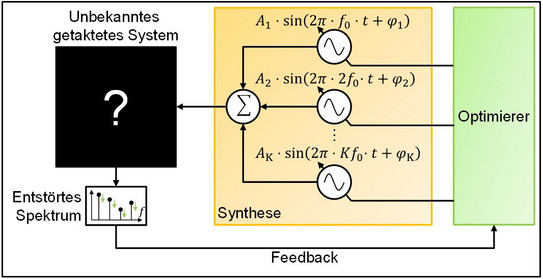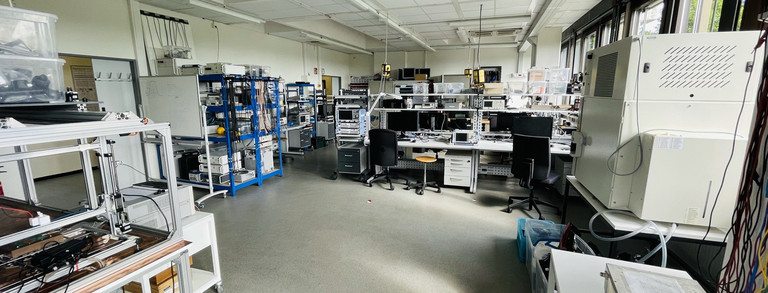Active negative feedback
Introduction: Active Noise Cancellation
In the field of on-board systems, active noise cancellation concepts for electromagnetic disturbances are investigated and developed. The basic concept is widely used in the field of acoustics under the term "Active Noise Cancellation". In this method, the interference is superimposed by counter-interference, resulting in destructive interference so that the interference is eliminated.

Application to electromagnetic interference

Passive filter structures comprising capacitors, coils and shields are commonly used in power electronic converters to reduce noise emission. In order to increase power density and reduce costs, these elements are to be replaced by active negative feedback structures, which are essentially based on silicon semiconductors. Previous implementations of active negative feedback structures in EMC use analog circuit technology. The research area of on-board systems is pioneering the use of digital FPGA signal processing systems, which enable the implementation of innovative and comprehensive methods.
Universal FPGA development environment
Programmable FPGA development boards are versatile platforms for the realization of various prototypes. The work area on-board systems has been able to gain extensive experience with different systems in various projects. The focus was and still is on efficient and user-friendly programming in order to be able to carry out any investigations quickly, flexibly and systematically. For this purpose, a development environment was set up with which the FPGA logic can first be defined, simulated and optimized in Matlab Simulink. Subsequently, the model-based developed logic can be translated and loaded onto the FPGA IC. Especially for the realization of adaptive negative feedback, this flexible system opens immense possibilities. Against the background of possible applications on the market, the research area of on-board systems is also investigating hardware-reduced realizations of the methods and strategies developed.

Adaptive negative feedback of harmonics

A special method is the active negative feedback of the disturbances of (quasi-)stationary clocked systems. In these systems, interfering harmonics are formed due to the clocking, which include the fundamental wave and the associated harmonics. To suppress these systems, it is sufficient to suppress exactly these frequency components. To realize this, a sine wave corresponding in frequency is generated for each interfering harmonic. An optimizer is used to determine the necessary amplitude and phase, which may include complex calculations or simple search algorithms. This describes a counter-coupler which adapts to the interfering system.
Demonstrator
For demonstration purposes, the method was implemented on an FPGA system and applied to a test setup. The test subject is a DC/DC converter, which here connects the on-board voltages of 48 V and 12 V with each other. The 48 V-side disturbances are measured with the help of an on-board power supply replica and a spectrum analyzer. The FPGA system measures the disturbances at the on-board network replica as a feedback signal in order to optimize the negative feedback. A simple ring ferrite with two windings of two turns each is provided to inject the negative feedback. The drive signal of the converter is generated by the FPGA system to achieve complete synchronization between disturbances and counter-interference. To avoid interfering ground loops, a digital isolator is used for galvanic isolation.

Measurement

As an example, the long and medium wave range (150 kHz-1.8 MHz [CISPR 25]) was suppressed using adaptive negative feedback. It can be seen that all the harmonics considered were significantly reduced (in some cases by more than 60 dB), which means that the system now complies with limit class 5 of CISPR 25. Adaptive negative feedback of harmonics is thus an effective method for suppressing the harmonics of stationary clocked systems.

